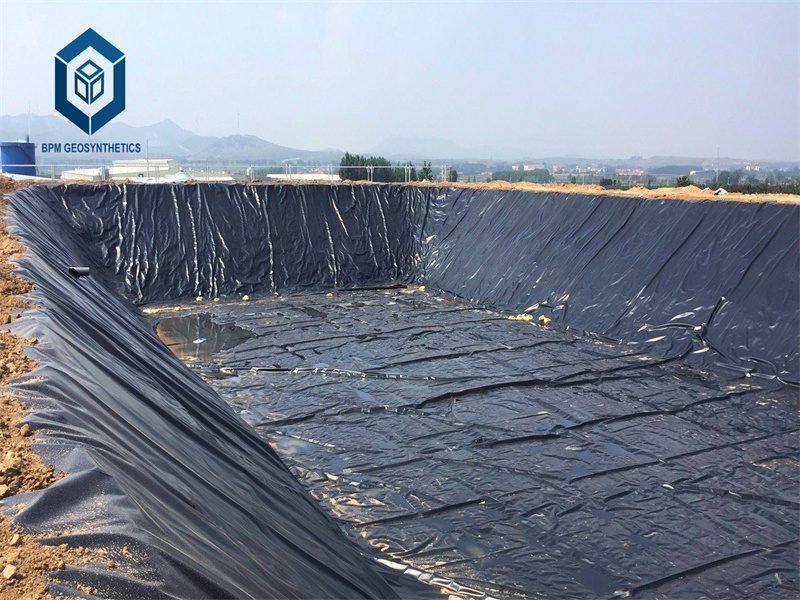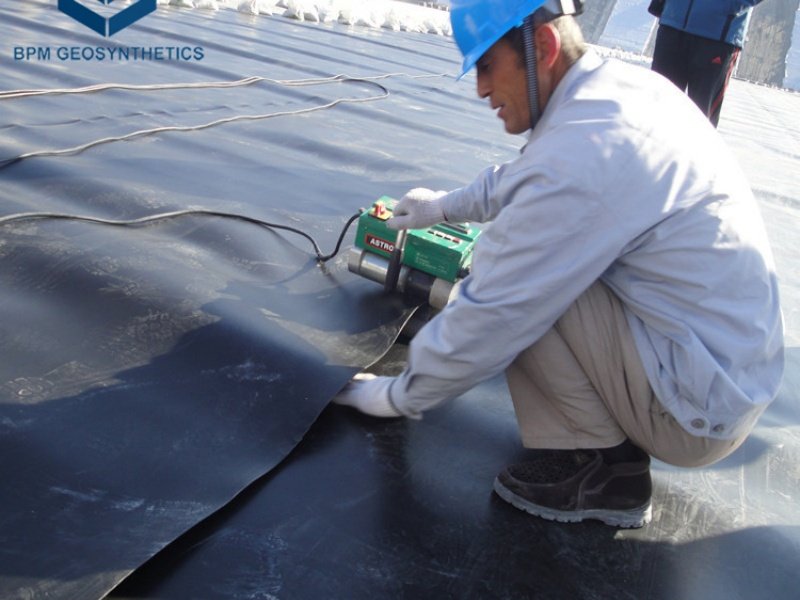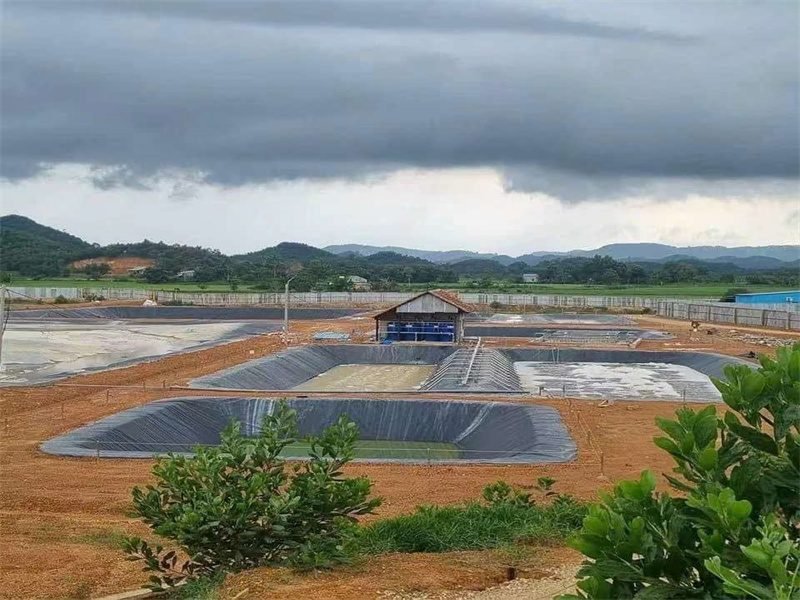In modern industrial projects, the importance of anti-seepage technology is becoming increasingly prominent. Whether it is a landfill, sewage treatment plant, chemical enterprise, or mining project, reliable anti-seepage measures are needed to protect the environment, prevent resource waste, and avoid potential safety hazards. As an efficient, economical and environmentally friendly anti-seepage material, anti-seepage Impermeable Geomembrane Liner has gradually become the first choice in the field of industrial anti-seepage due to its unique performance and wide range of applications. This article will introduce the 7 major characteristics of anti-seepage Impermeable Geomembrane Liner in detail to help readers better understand its advantages and application value.
1.Impermeable Geomembrane Liner – Excellent anti-seepage performance
The main components of Impermeable Geomembrane Liner are usually polymer materials such as high-density polyethylene (HDPE) or polyvinyl chloride (PVC).they have extremely low permeability coefficients, usually below 10⁻¹⁰ cm/s. This means that even during long-term use, it is difficult for liquids to leak through the Impermeable Geomembrane Liner. For example, in landfills, Impermeable Geomembrane Liner can effectively prevent leachate from penetrating into the soil and groundwater, thereby avoiding pollution to the surrounding environment. Compared with traditional anti-seepage materials (such as clay and concrete), Impermeable Geomembrane Liner are not only better in anti-seepage effect, but also more convenient to construct and have a longer service life.

2. Impermeable Geomembrane Liner – Excellent chemical stability
2.1. Acid and alkali corrosion resistance
Impermeable Geomembrane Liner (such as HDPE geomembranes) have stable molecular structures in strong acid (such as sulfuric acid, hydrochloric acid) or strong alkali (such as sodium hydroxide) environments, and are not prone to chemical reactions or degradation.
2.2. Resistance to organic solvent erosion
It has high tolerance to organic solvents such as oils (such as diesel, gasoline), aromatic hydrocarbons (such as benzene, toluene), and ketones (such as acetone), and will not swell or dissolve.
2.3. Anti-oxidation and anti-reduction performance:
In oxidizing (such as chlorine disinfectants, hydrogen peroxide) or reducing (such as sulfide) environments, the molecular chains of Geomembrane Liner are not easy to break and maintain mechanical strength. Typical applications: Landfill cover (need to resist oxidizing substances in leachate). Mine tailings pond (sulfide wastewater).
2.4. Salt corrosion resistance Performance:
It has long-term tolerance to high concentrations of salt in seawater (such as sodium chloride, magnesium sulfate) and industrial salt solutions, and will not cause material degradation due to ion penetration. Application scenarios: Coastal breakwater anti-seepage layer. Salt chemical production pool (such as chlor-alkali industry). Test results: After immersion in 5% NaCl solution for 10 years, the elongation at break of HDPE Impermeable Geomembrane Liner is still >700%.
2.5. Antimicrobial and biodegradable
The surface of the Impermeable Geomembrane Liner is smooth and not easy to attach microorganisms; the polymer material itself is difficult to be decomposed by microorganisms, and is suitable for long-term burial or underwater environments.
2.6. UV resistance and ozone aging
After adding anti-UV agents and antioxidants, the molecular chain of the Impermeable Geomembrane Liner is not easy to break under long-term outdoor exposure, and the color and performance are stable.
2.7. Analysis of chemical stability mechanism
Geomembrane Liner (such as HDPE) is a linear polymer chain with strong intermolecular forces and high chemical bond energy, which is difficult to be attacked by chemical substances.

3.Impermeable Geomembrane Liner – High strength and durability
The high strength and durability of the anti-seepage Geomembrane Liner are its core advantages: its tensile strength reaches 17~40 MPa, and its elongation at break is as high as 600%~800%. It can withstand strong tension and deformation, and adapt to complex terrain and foundation settlement; it has excellent puncture and tear resistance, and can effectively resist sharp objects and crack propagation. In terms of durability, it is resistant to aging, chemical corrosion, high and low temperature (-70℃ to 80℃), has an outdoor life of more than 50 years, and has extremely low maintenance costs. The material has a stable molecular structure and will not degrade after long-term use, providing reliable protection for industrial anti-seepage projects and significantly reducing the cost and risk of the entire life cycle.
4.Impermeable Geomembrane Liner – Good flexibility and adaptability
The flexibility and adaptability of Impermeable Geomembrane Liner are outstanding: it is soft and highly plastic, and can fit tightly to complex terrain (such as slopes, curved surfaces, and irregular pits), avoiding stress concentration and hollowing problems that are prone to occur with traditional rigid materials; the material can be bent, folded, and hot-melt welded, making it easy to transport and construct, and is especially suitable for operations in narrow or irregular spaces; it is resistant to low temperatures and does not crack, nor does it flow at high temperatures, and has a wide range of environmental adaptability; at the same time, it can extend synchronously with slight settlement or deformation of the foundation, and is not easy to tear, ensuring the long-term integrity of the anti-seepage layer, significantly improving project reliability and construction efficiency, and is an ideal anti-seepage material under complex working conditions.
5. Impermeable Geomembrane Liner – Aging and UV resistance
The aging resistance and UV resistance of Geomembrane are the key guarantees for their long-term reliability:
UV resistance mechanism: by adding light stabilizers such as carbon black, it can absorb more than 99% of UV rays, avoid polymer chain breakage, and delay material degradation;
Aging resistance: in outdoor natural environments, after 5,000 hours of UV radiation, the tensile strength retention rate is still >90%, and the service life exceeds 50 years;
Environmental adaptability: resistant to high and low temperatures (-70℃ to 80℃) and resistant to ozone aging, suitable for extreme climates and long-term exposure scenarios;
Engineering value: significantly reduce maintenance costs, avoid leakage risks caused by aging, and ensure the long-term integrity of the anti-seepage layer.

6. Impermeable Geomembrane Liner – Convenient and efficient construction
Installing an anti-seepage geomembrane is quick and easy. It mainly involves three steps:
(1) Laying – Unroll the geomembrane over the area.
(2)Welding – Seal the seams (usually with heat) to make sure it’s watertight.
(3) Fixing – Secure the edges with weights or anchors.
Since geomembranes are lightweight, they’re easy to transport and install—even for big projects. Compared to old-school concrete liners, they savea lot of time. For example, a medium-sized landfill using geomembranes might take only 1/3 of the time needed for concrete.
Another big advantage? They fit any shape! Whether the ground is flat, sloped, or uneven (like ditches or hills), geomembranes can be laid smoothly without leaks.
7. Impermeable Geomembrane Liner – Environmental protection and economy
As people care more about the environment, industries need greener anti-leak solutions. Geomembranes are a great choice because:
(1) Safe & Non-Toxic – Made from clean plastic (polymer), they’re odorless and pollution-free.
(2) Stop Pollution – Used in landfills and sewage plants, they block harmful chemicals from leaking into soil and water.
(3) Long-Lasting – They don’t need frequent replacement, saving resources and reducing waste.
(4) Nature-Friendly – Even used in wetlands and soil cleanup projects, they protect groundwater without harming ecosystems.
Bottom line: Geomembranes keep the environment safe—durably and affordably!
8.Conclusion
With its excellent anti-seepage performance, super durability, convenient and efficient construction, and environmental friendliness, anti-seepage Geomembrane liner has become the preferred material in the field of industrial anti-seepage. With increasingly stringent environmental protection today, anti-seepage Impermeable Geomembrane Liner can not only effectively prevent the leakage of pollutants and protect the ecological environment, but also save a lot of capital investment for enterprises, achieving a win-win situation of economic and environmental benefits. With the continuous advancement of technology and the increase in market demand, the application prospects of anti-seepage Impermeable Geomembrane Liner will be broader. We call on more industrial projects to give priority to anti-seepage Impermeable Geomembrane Liner in anti-seepage design, and jointly contribute to environmental protection and sustainable development.




